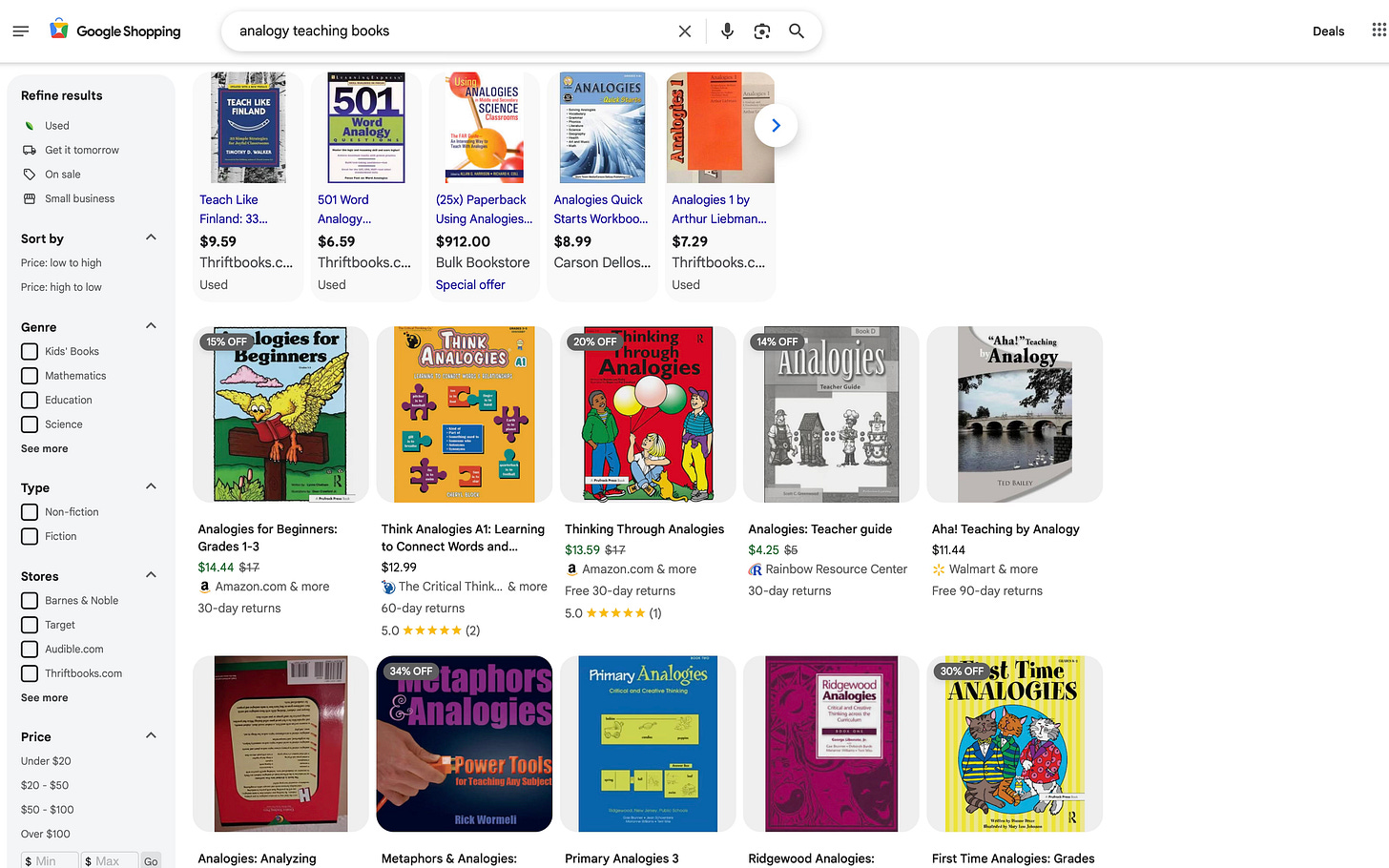🦄 The Mysterious Disappearing Analogy Book
Analogies : Learning :: Breathing : _____
the disposable example problem: when schoolbooks offer little beyond samples or tutorials; the lack of “disposable” practice problems to interleave and reenforce
Analogies : Learning :: Breathing : Living
I started high school in 2003. Vocabulary books formed a weekly routine: Monday’s meant fetching dictionaries, searching words, and verbal reasoning. Friday’s meant short tests. Vocabulary often doubled as spelling. If we figured twenty words for thirty-six weeks, then we might have talked 720 words per year. (Somewhere in the ballpark!)
The SAT had analogies then. Since topics trickled down, these exercises were everywhere. (I actually enjoying them!) But the College Board eliminated SAT’s in 2005, converting “verbal reasoning” to “critical reading.” Since this was the year before I took the test, I was none the wiser. I had already benefited from years of preparation.
Fast forward.
I graduated high school in 2007, college in 2011, and, after a quick Transition to Teach program, started teaching in 2013. Since 2013 a silent yet tectonic shift has happened with school books. While I can’t provide specific dates, times, and reasons, I’ll offer five observations:
1. Textbooks merged with workbooks and became subscriptions. Disposable.
2. These inflated, disposable books moved some literature online as a “feature.”
3. Canon debates likely helped trade classic literature for cheaper substitutes.
4. Auxiliary vocabulary and grammar books simply faded.
5. Most 1:1 initiatives meant going paperless. Many classrooms purged themselves of dictionaries, thesauruses, and other antiquated references. (Including past textbooks!)
The literature aspect deserves its own post. (See my Notes below.) But I want to zoom closer to the analogies part.
My degree is in Philosophy. (With enough English courses that made my Praxis test easy.) Books about cognition and creativity line my “teaching” bookshelves: Shortcut (Pollack), I Is An Other (Geary), Metaphors We Live By (Lakoff and Johnson), and more.
As a thinking skill, analogical reasoning takes far less preparation than syllogistical reasoning—although I’d teach both in a perfect world. Conceptually, analogies blend with other topics like text structure, sharing relationships like analysis (whole-part), categorization (category-example), comparisons (synonyms), cause-effect, and so on.
Once students explain analogies, comparisons become more abstract as analogies (A is like B) become metaphors (A is B). Other transformations include personification (animals as people), objectification (people as objects), symbols (concrete nouns as abstract nouns), allegories (story as symbol), and more. This simple tool explodes our understanding!
In a perfect world, analogies serve as tutorial to metaphorical writing.
The Missing Books (Elementary or LSATs)
Yet try finding analogy books today. No, really, go ahead and search on Google or Amazon. The result either skew elementary or LSAT-level with little in between. And while I truly applaud those authors I have purchased, the books remain… limited.
Example: I love the book Analogies for Critical Thinking, Grade 6. It does a wonderful job introducing relationships. Each chapter contains completing the pair problems, matching the relationship problems, and some basic writing. Nevertheless, it falls short with one simple yet unavoidable problem: Lack of examples.
I call it the "disposable example problem": Where teaching books function as tutorials with few practice problems. This holds true with sentence combining, sentence diagramming, and more. All dead ends. You learn without problems to burn. Presentation with little practice.
Frankly, a lotta practice helps sometimes.
Then again, have you ever tried creating your own analogy problems? While we compulsively compare, creating those dense, beautiful problems takes time. Like digging holes with plastic spoons!
AI Won’t Fix This One (Entirely)
When I rehearse the “disposable example problem” to others, AI has brought a predictable response: Why not just use Magic School or something to create problems? I mean it sounds simple enough. “Hey, generate 20 analogy problems.” And that works. A few times.
While a thought experiment bears this out in thirty seconds, five minutes generating questions might produce similar results. Consider the variables:
How many repetitions create redundant problems?
What analogy-relationship types? What themes?
What question types? What vocabulary difficulty?
How should incorrect answers be generated?
If we consider basic principles from the Science of Learning, I’d expect a different set of questions:
Should blocked practice serve as initial exposure only?
How should relationship types be spaced and interleaved?
How should relationship types be sequenced to allow interleaving?
How can the testing effect help cement analogical reasoning?
By the way, my initial chats with Gemini revealed something like four question types:
Completing the Pair: A : B :: C : ___. Complete “D.”
Matching the Relationships. A : B :: ___. Complete “C : D.”
Odd One Out. A : B :: ___. Find the example which doesn’t fit.
Identifying Analogies. Match the example with type.
Call this the driving quirk and limitation of my mind: Everything must connect. Analogies connect so effortless with text structure, graphic organizers, metaphorical writing, and even logic (as a branching form of reason). But if you just generate random questions without thinking yourself, you’ll get random results.
Without frameworks, randomly generated problems collapse into incoherence. Surely, creating analogy questions with artificial intelligence is no vice. Yet without careful curation, without guiding principles, the overlap and wrong answers will produce just more AI slop. However, this might prove especially dangerous when teaching reasoning.
A Hypothetical Book
That said, since June I’ve created somewhere over a thousand example problems. I’ve experimented with many different frameworks, both for overall organization and the activity sheets themselves. And while these early efforts need work, they’re something.
So let’s say I want to create between 30-40 assignments, allowing for teaching analogies to multiple grades at once. Let’s say I want to pay lip service to the Science of Learning. What creative constraints might I follow? A few stand out:
1. All analogy types must connect organically with writing exercises. The end result must become the foundation for metaphorical writing, extended from paragraphs to short essays.
2. Introductions will include limited, blocked practice, thereafter mixing with previous relationship types to include both spacing and interleaving.
3. All sections or chapters must include cumulative practice, ranging from multiple relationship types to question types to short retrieval practice style quizzes.
4. All sections must diverge enough that the same relationship type can be taught to multiple grade levels at once with minimal overlap. In other contexts, this would provide teachers with single grade levels many many more chances at practice.
5. After the included relationship types have been introduced, students must have the opportunity for relentless practice.
If this sounds like a tall order, I’m linking an example page with proof of concept. (See below.) In the meantime, while I’m sitting on frameworks and examples, I’m not quite ready to post them yet. But maybe sometime this school year.
Anyways, let me know what you think.
🎁 New to the blog? Check out my recent starter pack as well as a Google Drive Folder with FREE classroom resources! Also, The Honest School Times has your schooling satire.
⏰ Recent Posts
🏆 Fan Favorites
✏️ Teach Writing Tomorrow
📓 Other Writing Tricks






